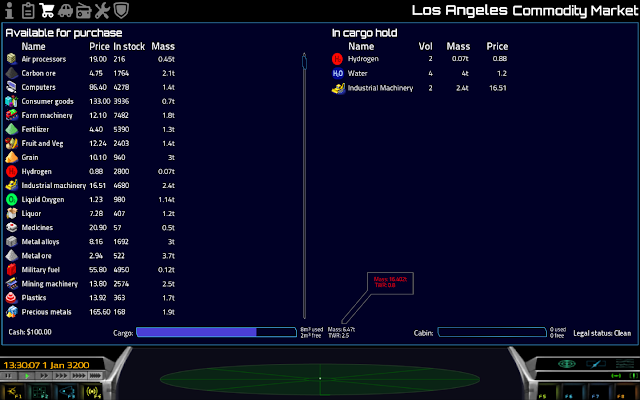I think we need both volume and mass, for both equipment and cargo.
I'd probably keep volume coarsely grained as it's only needed for managing free internal space and stuff to occupy it with - cubic meters or whatever we consider the volume of our standarized container will do.
Maximum allowed mass is not needed, on the surface inability to lift-off makes safety limit redundant unless we want to make player's overloaded ship collapse into a crumpled heap of scrap for its own sake, in space the only thing stressing the construction is ship's own thrust, and it can be presumed capable of handling that.
Some liftoff acceleration and surface gravity meters would be useful displayed in both the commodity market and shipyard, so that the player could know what they can and cannot afford to do.
Tracking volume along with mass (which we need for jump ranges and physics) has a few things going for it:
- It makes sense. You can fit limited volume, not mass into a spaceship's hull and different things have different densities.
- It allows for more interesting cargo management and more conditions affecting how valuable given cargo seems to the player.
- It allows balancing space taken by equipment and hindrance caused by it separately from each other. For example equipment meant for fighters or couriers could be relatively low mass allowing ship to be filled leaving little cargo space, but retaining most of their agility, OTOH other kinds of equipment could hinder ship physically without affecting capacity much.
- It allows variable mass equipment and equipment that should reserve space like all sorts of tanks, ammo-based weapons, ship and drone docking bays and so on.
impaktor wrote:You should not be able to fit an engine bigger than your ship, but should filling your ship with a smaller engine allow you to fit ECM, radar mapper, scanner, ... or do they go on the outside of the ship? I.e. would engine compete with the same volume as all other equipment?
(...)
I say keep things simple. All equipment have negligible volume except engine and passenger cabin, and maybe shield generator.
I strongly disagree.
You shouldn't be able to fit many things bigger than your ship - guns, shields, and so on.
And since we cannot predict what kinds of equipment could be added further down the road that we might want to forbid fitting on a too small ship and to track volume of selectively, we should track all the volumes.
Of course, some compartmentalization with separate cargo, engineering, forward and backwards weapon bays and so on, could be called for and be used to diversify ships by different models allocating different capacities to different compartments, but that's rather antithetical to keeping things simple so maybe it should be added further down the line if ever. ;)
As for the missiles I'd get rid of the pylons (since they never really worked well in Frontier) and have missiles carried in cargo bay and jettisoned on launch and separate type of missiles fired from launchers with considerable initial velocity - the launchers themselves would be considered guns and excess ammo packs (of fixed amount of rounds) could be carried as cargo. Pylons could replaced 1-to-1 with additional generic hardpoints since we're going to need more of them if we are to have more weapon diversity, but that's material for whole other thread regarding combat.
nozmajner wrote:But this also veers into the question of tailsitters since it doesn't makes sense that you can't use your most powerful thrusters for liftoff. This could be alleviated with a mechanic thing that rotates the ship up upon liftof if needed.
That doesn't really help if you can't use your most powerful thrusters for landing safely. :P
I'm all for tailsitters, although high thrust, very low ISP belly thrusters for liftoff/landing (cold thrust, if you will, to not vaporize the pad) could be enabled when deploying landing gear as an alternative.
Also there's a potential issue with Autopilot if you are able to overload your ship. It uses your retro thrusters for landing, which are much weaker then belly or main ones for most ships.
That's the problem with autopilot, though. It should be fixed anyway since its bad mechanically AND it looks wrong.
Or like only having 1t of that on all ships to act as a buffer. I think the current model of separate tank is reasonable for one reason: A propellant tank is already in the ship, but you need some kind of container for any propellant in your cargo hold, so 1m3 of hydrogen could mean less than 1m3 of hydrogen if you refuel. Might be not that much impact, I can't really tell how much a 1m3 liquid hydrogen tank weighs.
I imagine it a hassle with plumbing and such too (refueling could also take some time). And having a dedicated tank helps differentiate ships too. Also there are things like wings on some crafts which are a nice place for propellant storage, but you can't really store Industrial machinery or a passenger cabin there.
True, though 1t buffer has the advantage of least logic needed for the desired effect - with autorefueler and delta-v counting the cargo bay propellant which are needed anyway to take advantage of extra propellant and reduce tedium - it would not require any new functionality to let player dump or sell excess propellant.
Cargo bay propellant cannot have containers, since that would mean extra containers being magically summoned when, for example, scooping fuel, and mass discrepancies when converting between tank and cargo bay. Let's not go there.
We can consider all harvestable gases/liquids to be stored in variable volume bladders that extend into cargo space (contractile bladders or pistons would be nice when getting the contents out of the tanks).
Alternatively, we can keep large, ship-dependent tanks, but prohibit carrying scoopables in cargo bay - additional tanks could be installed as optional equipment. This would require dedicated means of dumping the contents, and some way to reserve fuel (with unit buffer it could be as simple as converting fuel to and from additional cargo type representing reserved fuel).

